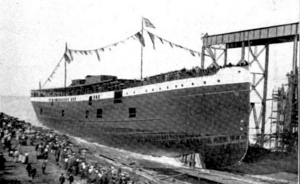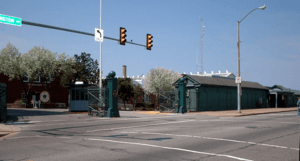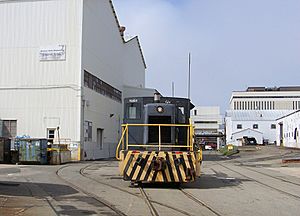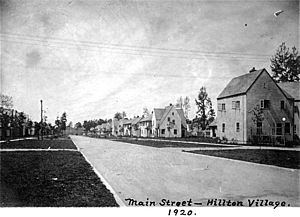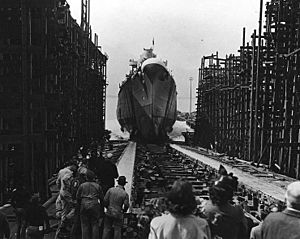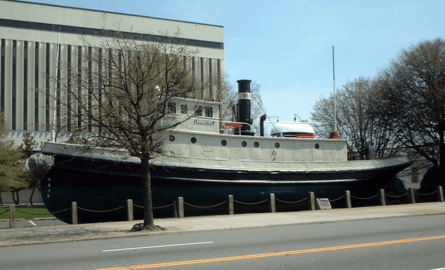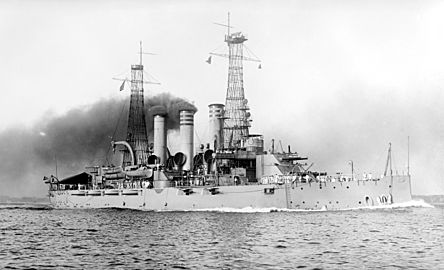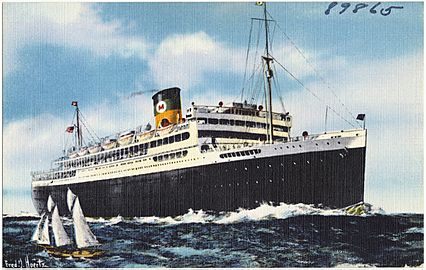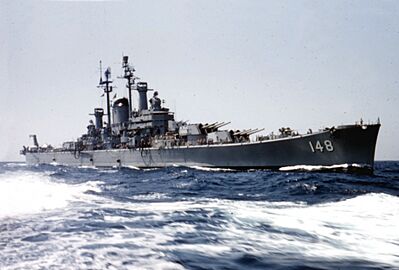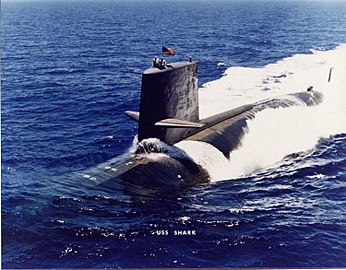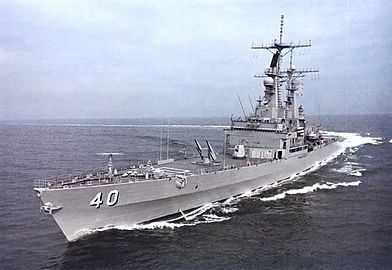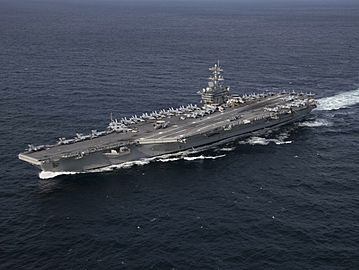Newport News Shipbuilding facts for kids
Newport News Shipbuilding (NNS) is a big company that builds and fixes ships for the United States Navy. It's part of Huntington Ingalls Industries. This shipyard is the only place in the U.S. that designs, builds, and refuels huge aircraft carriers. It's also one of only two places that builds submarines for the Navy.
The company started in 1886 as the Chesapeake Dry Dock and Construction Co. Since then, it has built over 800 ships, including both Navy ships and commercial ships. The shipyard is located in Newport News, Virginia. Its facilities cover more than 550 acres (2.2 square kilometers).
Newport News Shipbuilding is a very important employer. It provides many jobs for people living in the lower Virginia Peninsula and other nearby areas, including parts of North Carolina.
Right now, the shipyard is busy building two new Gerald R. Ford-class aircraft carriers. These are the USS John F. Kennedy (CVN-79) and the USS Enterprise (CVN-80).
In 2013, the shipyard also started taking apart the first nuclear-powered aircraft carrier, USS Enterprise (CVN-65). This was the same ship they built many years ago.
Newport News Shipbuilding also does a special job called "Refueling and Complex Overhaul" (RCOH). This is a four-year project to update and refuel Nimitz-class aircraft carriers. It's like a huge check-up and upgrade for these massive ships. The shipyard has already finished this work for five Nimitz-class carriers. As of 2017, they were working on the sixth one, USS George Washington.
Contents
History of the Shipyard
The story of Newport News Shipbuilding began with a man named Collis P. Huntington. He was an industrialist who helped finish the Chesapeake and Ohio Railroad (C&O) in the 1870s. This railroad connected Richmond, Virginia, to the Ohio River. It was used to transport coal from West Virginia.
In 1881, the C&O railroad was extended to Newport News Point. Here, a new pier was built to load coal onto ships. But Huntington had bigger plans for Newport News.
How the Shipyard Began
In 1886, Collis Huntington decided to build a shipyard to fix ships that used his new transportation hub. The shipyard was called the Chesapeake Dry Dock and Construction Co.
In 1891, Newport News Shipbuilding and Drydock Company delivered its very first ship. It was a tugboat named Dorothy. By 1897, the shipyard had already built three warships for the U.S. Navy. These were USS Nashville, Wilmington, and Helena.
When Collis Huntington passed away in 1900, his nephew, Henry E. Huntington, took over the leadership of the company. Under Henry's guidance, the shipyard continued to grow and build more ships.
Around 1906, a new type of powerful warship called a "dreadnought" was invented. Between 1907 and 1923, Newport News built six of these large battleships for the U.S. Navy. Most of these ships were used in World War II. In 1907, President Theodore Roosevelt sent the Great White Fleet on a trip around the world. Seven of the 16 battleships in that fleet were built at Newport News.
In 1914, the shipyard built the SS Medina. This ship later became the MV Doulos, which was the world's oldest active ocean-faring passenger ship until 2009.
Newport News City and the Shipyard
In the early days, the leaders of the Newport News community and the shipyard were often the same people. For example, Walter A. Post was president of the shipyard and also the first mayor of Newport News.
Another president, Albert Lloyd Hopkins, sadly died in 1915. He was traveling to England on shipyard business aboard the RMS Lusitania when it was sunk by a German U-boat. His assistant, Frederic Gauntlett, survived.
Homer L. Ferguson became president after Hopkins. He led the company through both world wars. Ferguson was also a well-known community leader. He helped start the Mariners' Museum with Archer Huntington.
To house the many shipyard workers, the government built Hilton Village in 1918. This was one of the first planned communities in the country. It had 500 homes designed in an English village style. After World War I, Henry Huntington bought Hilton Village. He helped shipyard employees and other local people buy these homes. Three streets in Hilton Village are named after former shipyard presidents: Post, Hopkins, and Ferguson.
The sinking of the Lusitania was one reason the United States joined World War I. From 1918 to 1920, Newport News Shipbuilding delivered 25 destroyers. After the war, the shipyard started building aircraft carriers. They delivered USS Ranger in 1934, followed by Yorktown and Enterprise.
Building Ocean Liners
After World War I, Newport News Shipbuilding did a huge renovation on the ocean liner SS Leviathan. This ship had been a German liner called Vaterland. During the war, the U.S. government took it over and used it as a troopship. The shipyard completely rebuilt it, making it almost a new ship. In 1923, the SS Leviathan became the main ship for United States Lines.
In 1927, the shipyard launched the world's first large "turbo-electric" ocean liner, the SS California. This meant it used electricity to power its propellers. It was the biggest merchant ship built in the U.S. at that time. Newport News also built its sister ships, Virginia and Pennsylvania. They also built two even larger liners, the SS President Hoover and President Coolidge.
In 1939, the SS America was launched. It served with United States Lines but was soon changed into a troopship for World War II, called USS West Point.
By 1940, the Navy had ordered many more ships, including a battleship, seven aircraft carriers, and four cruisers. During World War II, Newport News Shipbuilding built ships very quickly as part of the U.S. government's emergency program. They built many "Liberty ships," which were cargo ships needed during the war.
The shipyard even started another emergency shipyard called the North Carolina Shipbuilding Company. This new yard built 243 ships, including 186 Liberty ships. For its great work during the war, the Navy gave the company its "E" pennant, which meant "excellence in shipbuilding."
Ships After the War
After World War II, Newport News Shipbuilding built the famous passenger liner SS United States. This ship set a speed record for crossing the Atlantic Ocean that still stands today!
In 1954, the shipyard worked with Westinghouse and the U.S. Navy. They developed and built a test nuclear reactor for a carrier's power system. This led to Newport News designing the USS Enterprise in 1960, which was the world's first nuclear-powered aircraft carrier. In 1959, the shipyard launched its first nuclear-powered submarine, USS Robert E. Lee.
In the 1970s, Newport News built some of the largest tankers ever made in the Western Hemisphere. They also built three ships that carry liquefied natural gas. These were the biggest ships of their kind ever built in the United States.
In the 1980s, the shipyard continued to build many Navy ships. These included Nimitz-class nuclear aircraft carriers and Los Angeles-class nuclear attack submarines. Since 1999, the shipyard has focused only on building warships for the Navy.
Submarine Building Challenges
In 2007, the U.S. Navy found that workers had used the wrong metal to join pipes on submarines being built. This could have caused cracks and leaks later. In 2009, it was discovered that bolts in the weapons systems of four Navy submarines were installed incorrectly. This caused delays in launching those submarines while the problems were fixed.
Company Changes
In 1968, Newport News Shipbuilding joined with Tenneco Corporation. Then, in 1996, Tenneco decided to make Newport News a separate company again.
In 2001, another company called General Dynamics tried to buy Newport News. If this had happened, there would have been no competition for building the Virginia-class submarines. These submarines were only made by Newport News and General Dynamics' other company, Electric Boat.
However, Northrop Grumman also made an offer to buy Newport News. The Department of Justice stopped General Dynamics' offer because it would create a monopoly. So, Northrop Grumman bought the company for $2.6 billion and renamed it "Northrop Grumman Newport News."
Later, in 2008, this division joined with Northrop Grumman Ship Systems and was called "Northrop Grumman Shipbuilding." Finally, in 2011, the company became its own separate company again, called Huntington Ingalls Industries, Inc. You can find its shares traded on the New York Stock Exchange.
Leaders of the Shipyard
- Matt Mulherin (2011-2017)
- Jennifer Boykin (2017–present)
Ships Built at Newport News
| Launch Date | Yard No. | Ship | Class and type | Operator | Notes | Ref |
|---|---|---|---|---|---|---|
| 1891 | Dorothy | The shipyard's first vessel, delivered in 1891. It is now on display at the yard. | ||||
| March 24, 1898 | Kearsarge | Kearsarge-class battleship | United States Navy | |||
| March 24, 1898 | Kentucky | Kearsarge-class battleship | United States Navy | |||
| October 4, 1898 | Illinois | Illinois-class battleship | United States Navy | |||
| November 10, 1900 | Arkansas | Arkansas-class monitor | United States Navy | One of the last monitor warships built for the U.S. Navy. | ||
| April 18, 1903 | West Virginia | Pennsylvania-class cruiser | United States Navy | |||
| September 12, 1903 | Maryland | Pennsylvania-class cruiser | United States Navy | |||
| April 6, 1904 | Virginia | Virginia-class battleship | United States Navy | |||
| April 3, 1905 | Binghampton | ferryboat | New York Harbor | This was the last surviving steam ferry built for New York Harbor when it was taken apart in 2017. | ||
| October 6, 1906 | North Carolina | Tennessee-class cruiser | United States Navy | |||
| December 15, 1906 | Montana | Tennessee-class cruiser | United States Navy | |||
| March 9, 1907 | Minnesota | Connecticut-class battleship | United States Navy | |||
| 1908 | Georgia | Oil tanker | M.V. Dutch Tanker & Oil Company | |||
| February 6, 1909 | Delaware | Delaware-class battleship | United States Navy | |||
| 1910 | J. A. Chanslor | Oil tanker | Associated Oil Company | |||
| May 18, 1912 | Texas | New York-class battleship | United States Navy | This is the only surviving "dreadnought" battleship. | ||
| September 14, 1912 | Proteus | Proteus-class collier | United States Navy | |||
| April 26, 1913 | Nereus | Proteus-class collier | United States Navy | |||
| August 22, 1914 | 176 | Medina | Cargo ship | Mallory Steamship Company | This was the oldest passenger vessel when it retired in 2009. | |
| March 16, 1915 | Pennsylvania | Pennsylvania-class battleship | United States Navy | |||
| January 25, 1917 | Mississippi | New Mexico-class battleship | United States Navy | |||
| March 30, 1918 | Lamberton | Wickes-class destroyer | United States Navy | |||
| April 5, 1918 | Montgomery | Wickes-class destroyer | United States Navy | |||
| April 5, 1918 | Radford | Wickes-class destroyer | United States Navy | |||
| May 11, 1918 | Breese | Wickes-class destroyer | United States Navy | |||
| November 29, 1918 | Gamble | Wickes-class destroyer | United States Navy | |||
| February 15, 1919 | Ramsay | Wickes-class destroyer | United States Navy | |||
| February 14, 1920 | Abel P. Upshur | Clemson-class destroyer | United States Navy | |||
| March 20, 1920 | Maryland | Colorado-class battleship | United States Navy | |||
| November 19, 1920 | West Virginia | Colorado-class battleship | United States Navy | |||
| October 1, 1927 | 315 | California | Ocean liner | Panama Pacific Line | This ship used a special "turbo-electric" power system. | |
| 1928 | Virginia | Ocean liner | Panama Pacific Line | |||
| October 10, 1928 | 328 | Pennsylvania | Ocean liner | Panama Pacific Line | ||
| September 7, 1929 | Houston | Northampton-class cruiser | United States Navy | |||
| February 1, 1930 | Augusta | Northampton-class cruiser | United States Navy | |||
| December 9, 1930 | 339 | President Hoover | Ocean liner | Dollar Steamship Lines | ||
| February 21, 1931 | 340 | President Coolidge | Ocean liner | Dollar Steamship Lines | ||
| August 15, 1931 | Peten | Cargo liner | United Fruit Company | |||
| 1931 | Talamanca | Cargo liner | United Fruit Company | |||
| 1932 | Chiriqui | Cargo liner | United Fruit Company | |||
| February 25, 1933 | Ranger | Ranger-class aircraft carrier | United States Navy | This was the first aircraft carrier built specifically for the U.S. Navy. | ||
| April 4, 1936 | Yorktown | Yorktown-class aircraft carrier | United States Navy | |||
| October 3, 1936 | Enterprise | Yorktown-class aircraft carrier | United States Navy | |||
| December 3, 1936 | Boise | Brooklyn-class cruiser | United States Navy | |||
| December 8, 1938 | Mustin | Sims-class destroyer | United States Navy | |||
| December 8, 1938 | Russell | Sims-class destroyer | United States Navy | |||
| August 31, 1939 | America | Ocean liner | United States Lines | |||
| December 14, 1940 | Hornet | Yorktown-class aircraft carrier | United States Navy | |||
| November 21, 1941 | Indiana | South Dakota-class battleship | United States Navy | |||
| July 31, 1942 | Essex | Essex-class aircraft carrier | United States Navy | |||
| April 15, 1943 | Yorktown | Essex-class aircraft carrier | United States Navy | |||
| April 26, 1943 | Intrepid | Essex-class aircraft carrier | United States Navy | |||
| August 30, 1943 | Hornet | Essex-class aircraft carrier | United States Navy | This ship is now preserved as the USS Hornet Museum in Alameda, California. | ||
| October 14, 1943 | Franklin | Essex-class aircraft carrier | United States Navy | |||
| February 7, 1944 | Ticonderoga | Essex-class aircraft carrier | United States Navy | |||
| June 28, 1944 | Randolph | Essex-class aircraft carrier | United States Navy | |||
| December 14, 1944 | Boxer | Essex-class aircraft carrier | United States Navy | |||
| March 20, 1945 | Midway | Midway-class aircraft carrier | United States Navy | |||
| August 23, 1945 | Leyte | Essex-class aircraft carrier | United States Navy | |||
| April 2, 1946 | Coral Sea | Midway-class aircraft carrier | United States Navy | |||
| March 6, 1948 | Newport News | Des Moines-class heavy cruiser | United States Navy | |||
| June 23, 1951 | United States | Ocean liner | United States Lines | This ship holds the Blue Riband for fastest transatlantic crossing. | ||
| December 11, 1954 | Forrestal | Forrestal-class aircraft carrier | United States Navy | |||
| September 29, 1956 | Ranger | Forrestal-class aircraft carrier | United States Navy | |||
| December 18, 1959 | Robert E. Lee | George Washington-class submarine | United States Navy | |||
| March 16, 1960 | Shark | Skipjack-class submarine | United States Navy | This was the shipyard's first nuclear-powered submarine. | ||
| September 24, 1960 | Enterprise | Enterprise-class aircraft carrier | United States Navy | This was the world's first nuclear-powered aircraft carrier. | ||
| September 16, 1961 | Empire State VI | Troopship | United States Maritime Administration | |||
| February 1, 1964 | America | Kitty Hawk-class aircraft carrier | United States Navy | |||
| May 27, 1967 | John F. Kennedy | John F. Kennedy-class aircraft carrier | United States Navy | |||
| May 13, 1972 | Nimitz | Nimitz-class aircraft carrier | United States Navy | This ship is nuclear-powered. | ||
| December 14, 1974 | Virginia | Virginia-class cruiser | United States Navy | This ship is nuclear-powered. | ||
| August 9, 1975 | Texas | Virginia-class cruiser | United States Navy | This ship is nuclear-powered. | ||
| October 11, 1975 | Dwight D. Eisenhower | Nimitz-class aircraft carrier | United States Navy | This ship is nuclear-powered. | ||
| July 31, 1976 | Mississippi | Virginia-class cruiser | United States Navy | This ship is nuclear-powered. | ||
| October 21, 1978 | Arkansas | Virginia-class cruiser | United States Navy | This ship is nuclear-powered. | ||
| March 15, 1980 | Carl Vinson | Nimitz-class aircraft carrier | United States Navy | This ship is nuclear-powered. | ||
| October 27, 1984 | Theodore Roosevelt | Nimitz-class aircraft carrier | United States Navy | This ship is nuclear-powered. | ||
| February 13, 1988 | Abraham Lincoln | Nimitz-class aircraft carrier | United States Navy | This ship is nuclear-powered. | ||
| July 21, 1990 | George Washington | Nimitz-class aircraft carrier | United States Navy | This ship is nuclear-powered. | ||
| November 13, 1993 | John C. Stennis | Nimitz-class aircraft carrier | United States Navy | This ship is nuclear-powered. | ||
| September 7, 1996 | Harry S. Truman | Nimitz-class aircraft carrier | United States Navy | This ship is nuclear-powered. | ||
| March 4, 2001 | Ronald Reagan | Nimitz-class aircraft carrier | United States Navy | This ship is nuclear-powered. | ||
| October 9, 2006 | George H.W. Bush | Nimitz-class aircraft carrier | United States Navy | This ship is nuclear-powered. | ||
| October 11, 2013 | Gerald R. Ford | Ford-class aircraft carrier | United States Navy | This ship is nuclear-powered. | ||
| October 29, 2019 | John F. Kennedy | Ford -class aircraft carrier | United States Navy | This ship is nuclear-powered. |
Other important ships built at the Newport News yard include:
- Gerald R. Ford-class nuclear-powered aircraft carriers:
- USS Enterprise (CVN-80), which is currently being built.
- USS Doris Miller (CVN-81), which is also being built.
- Liberty ship transports, which were important for the Allies during World War II.
- Los Angeles-class nuclear-powered submarines.
- Virginia-class nuclear-powered submarines.
Images for kids
-
An F/A-18F Super Hornet jet approaching the Gerald R. Ford-class aircraft carrier.
Ships Rebuilt or Repaired
Newport News Shipbuilding has also done major rebuilding work on ships, such as:
- SS Jacona, which was the first floating electric power plant used for emergencies.
- Sea Witch, a wrecked ship. The shipyard saved its working back section and machinery. They used these parts to build a new chemical tanker, which was first called Chemical Discoverer and later Chemical Pioneer.
Shipbuilding Facilities in World War II
| Shipway | Width | Length | Type | Date |
|---|---|---|---|---|
| 2 | 76 ft (23 m) | 628 ft (191 m) | Inclined Slipway | |
| 3 | 76 ft (23 m) | 628 ft (191 m) | Inclined Slipway | |
| 4 | 76 ft (23 m) | 628 ft (191 m) | Inclined Slipway | |
| 5 | 76 ft (23 m) | 628 ft (191 m) | Inclined Slipway | |
| 6 | 96 ft (29 m) | 628 ft (191 m) | Inclined Slipway | |
| 7 | 76 ft (23 m) | 628 ft (191 m) | Inclined Slipway | |
| 8 | 111 ft (34 m) | 1,000 ft (300 m) | Semi-submerged Inclined Slipway | 1919 |
| 9 | 111 ft (34 m) | 1,000 ft (300 m) | Semi-submerged Inclined Slipway | 1919 |
| 10 | 128 ft (39 m) | 960 ft (290 m) | Graving Dock | 1941 |
| 11 | 140 ft (43 m) | 1,100 ft (340 m) | Graving Dock | 1941 |
See also
 In Spanish: Newport News Shipbuilding para niños
In Spanish: Newport News Shipbuilding para niños




